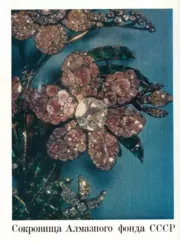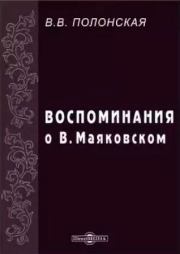Ю. Ф. Дюженко , Е. И. Смирнова - Сокровища Алмазного фонда СССР
 | Название: | Сокровища Алмазного фонда СССР |
Автор: | Ю. Ф. Дюженко , Е. И. Смирнова | |
Жанр: | Живопись, альбомы, иллюстрированные каталоги | |
Изадано в серии: | неизвестно | |
Издательство: | неизвестно | |
Год издания: | 1980 | |
ISBN: | неизвестно | |
Отзывы: | Комментировать | |
Рейтинг: | ||
Поделись книгой с друзьями! Помощь сайту: донат на оплату сервера | ||
Краткое содержание книги "Сокровища Алмазного фонда СССР"
В альбоме представлены избранные экспонаты выставки Алмазного фонда СССР.Цветные репродукции показывают исторические драгоценные камни, золотые и платиновые самородки, якутские алмазы, шедевры русского ювелирного искусства. Репродукции сопровождаются вступительной статьей и аннотациями. Подписи к иллюстрациям на русском, английском и французском языках.
Читаем онлайн "Сокровища Алмазного фонда СССР". [Страница - 4]
В ответ на антисоветскую пропаганду но личному указанию В. И. Ленина сокровища бывших русских царей были выставлены для обозрения в 1924 году в Колонном зале Дома Союзов. В 50-х годах, когда стало известно об открытии алмазов Сибири, газеты за рубежом писали о том, что русские алмазы появятся на мировом рынке только в XXI веке, так как эти алмазы залегают в труднодоступных малонаселенных местах, на тысячи километров удаленных от промышленных центров и путей сообщения. Но то, что казалось нереальным, стало явью. Советский народ под руководством Коммунистической партии и Советского правительства совершил еще один подвиг - на полюсе холода создал передовую алмазодобывающую промышленность. Освоение якутских месторождений - великая победа науки, великое достижение советского народа, положившее конец алмазной монополии капиталистических стран. Советский Союз стал добывать драгоценные камни и вышел на мировой рынок не в XXI веке, а через несколько лет после того, как ковш экскаватора зачерпнул нетронутую сибирскую землю. Она отдала свои богатства народу - подлинному хозяину. В бесконечном множестве сверкающих кристаллов Алмазного фонда СССР, так же как и в других свершениях нашего народа, отражены героические усилия советских людей, их постоянное стремление сделать все для счастья и процветания своей Родины.
THE USSR DIAMOND FUND is one of the world's largest collections of rare gems and jewelry of immense historic, artistic and material value.
Set up in honour of the 50th anniversary of Soviet power, the USSR Diamond Fund Exhibition has on display some of the most noteworthy historic and artistic objects which mirror the character and diversity of this unique collection.
The USSR Diamond Fund includes the historic jewels of Russia-gems, jewelry and the state regalia that became the property of the people after the October Revolution.
During the years of Soviet power, the treasures of the Diamond Fund have not only been preserved but considerably augmented. The Fund has been enlarged with particularly outstanding jewelry made of gems and precious metals as well as a large number of unrivalled diamonds from Soviet diamond fields.
Diamonds, whose name derives from the Greek adamant meaning unbreakable, hardest, have been known to man since remote antiquity. Pliny the Elder, the Roman scholar and writer who lived in the first century A. D., mentions man's persevering and age-long aspiration to make this remarkable crystal cut and drill the hardest materials. It was revered as a "royal stone" and valued more than any other treasure.
Diamonds were found rarely and far from every ruler could boast of having them in his possession.
There are many legends about diamonds, and belief in their magic qualities was sustained for long centuries.
They were held in esteem in Rus from time immemorial, for it was believed that they gave people strength and courage. In the 17th century they were widely used by Russian jewellers, and in the eighties of that century dazzling diamond crowns were made for the tsars Ivan and Peter by jewelsmiths at the Moscow Kremlin.
Jewelsmiths learned to facet diamonds, thereby laying bare their natural properties, their incomparable radiance, play of light and dazzle. The value of these precious stones rises considerably after they are cut.
Diamonds were held in particular esteem in the 18th century, which was the golden age of absolutist monarchies, whose grandeur and wealth was judged by the number and value of the diamonds in the official attributes of state power, i. е., in the paraphernalia of royalty.
The main items of this paraphernalia, which were always worn on solemn occasions, were a globe, a sceptre and a crown.
Every royal house sought to eclipse its rivals in wealth and in the beauty of its regalia. The Russian emperors aspired to have the most impressive crown jewels, and the royal treasures were therefore augmented with the most sumptuous regalia abundantly decorated with gems.
Because of the enormous material value as well as the political significance of these objects, which were symbols of power, they were closely guarded. An edict promulgated by Peter I stated that the regalia "shall be kept in the Treasury in a large chest with three locks, the keys to be in the possession of the President of the Chamber, a Councilor of the Chamber and the Royal Treasurer, and on State occasions the President and two Councilors of the Chamber shall go to the Treasury, unlock the aforementioned chest, take the appropriate objects of State and send them to the royal palace in the custody of two Councilors of the Chamber. After the State occasion the aforementioned objects shall be returned to the Treasury."
In addition to state regalia, the royal treasury contained rare precious stones and jewelry.
Interest in Russian gems increased in the 18th century with the development of mining in the Urals. Exquisitely beautiful multi-coloured precious and semi-precious stones flowed into the royal treasure-stores and were used for formal dresses, fans, snuff-boxes, valuable weapons and state awards. The noted jewelsmiths J. Posier and L. Duval worked at the royal palace in those days. Objects made by them, whose beauty and elegance delighted contemporaries, are now in the USSR Diamond Fund. Posier made the most magnificent crown in Europe, selecting the best jewels and pearls from the royal treasure-store for it. It was the symbol of state power in Russia for nearly a century and a half.
From time to time the royal treasure-store was augmented with unique, unrivalled precious stones. These stones are on display at the Exhibition. One of them was the bewitchingly beautiful Orlov diamond. Unusual in size, colour and purity, it is set in a sceptre. The famous spinel in the imperial crown is of an --">Книги схожие с «Сокровища Алмазного фонда СССР» по жанру, серии, автору или названию:
 |
| Михаил Александрович Лапиков, Юрий Александрович Погуляй, Константин Иванович Ситников и др. - Парабеллум. СССР, XXII век. Война в космосе (сборник) Жанр: Космическая фантастика Год издания: 2014 |
 |
| Виктория Трелина - Жила-была девочка: Повесть о детстве прошедшем в СССР Жанр: Современная проза Год издания: 2015 |




